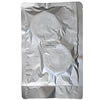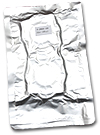
Secoh Pumps
Secoh pumps are top quality. There are a handful of components inside and little to go wrong. Basically the pump needs to draw a lot of clean, fresh air in and to be able to blow the air generated into unblocked pipework. They don't appreciate being flooded or exposed to the nasty smelly air inside a water treatment tank (and this invalidates any warranties too).
That's pretty much it .. we've gone into a little more details below to describe some of the more common situations we've seen over the past few years .. hopefully this is helpful, but if you need anything specific or want to chat through anything, give us a call on 0207 193 0852
That's pretty much it .. we've gone into a little more details below to describe some of the more common situations we've seen over the past few years .. hopefully this is helpful, but if you need anything specific or want to chat through anything, give us a call on 0207 193 0852
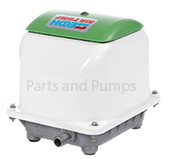
SLL40/50 & JDK40/50
Buzzing or Humming but no air.
Most likely, your diaphragms have torn. Depending on the installation diaphragms can last quite some time, but eventually .. moving backwards and forwards 50 times a second, something is going to give. Luckily, replacement is quick, easy and inexpensive.
The humming is coming from the drive coils to which the magnet, now immobile, is stuck to one side of. No air because the diaphragms (which generate the air) are now in need of replacing.
For a SLL or JDK pump younger than 4 years, a new filter and a pack of diaphragms is most likely all you'll need. If the pump is older than this it might well be worth putting a full service kit in. Double check the magnet though, as the pump will have still tried to run when the diaphragms started to go and they can sometimes get damaged.
Most likely, your diaphragms have torn. Depending on the installation diaphragms can last quite some time, but eventually .. moving backwards and forwards 50 times a second, something is going to give. Luckily, replacement is quick, easy and inexpensive.
The humming is coming from the drive coils to which the magnet, now immobile, is stuck to one side of. No air because the diaphragms (which generate the air) are now in need of replacing.
For a SLL or JDK pump younger than 4 years, a new filter and a pack of diaphragms is most likely all you'll need. If the pump is older than this it might well be worth putting a full service kit in. Double check the magnet though, as the pump will have still tried to run when the diaphragms started to go and they can sometimes get damaged.
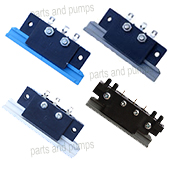
EL / JDK Autostopper failure
This doesn't happen very often, but when it does, nine times out of ten it is because the pump has been exposed to the noxious (and highly corrosive) gasses from within the main tank.
check the condition of the filter .. if it has any traces of dark residues (not just dust) it's a sign the pump is being exposed to those gasses (see on the right here for a particularly nasty example).
Best way of checking to see if the switch is the culprit is to try a few times to centre it .. if this still doesn't get your pump working again try to bypass the switch with a short piece of electrical cable joining the terminals from each end (if you switch has a centre terminal ignore it for the moment, as it's for the service or external light). Once the power is re-applied, if the pump does try to spring back to life it could well be the switch that's gone.
Replacement switches are HERE, but if the cause is the foul air / gas it's going to need investigating. Pipes leading from the pump to the tank air distribution system must be sealed on the outside, some tanks have rubber/silicon gaskets, some have silicon beads, some have expanded foam .. however your system is installed, any breach in this seal can have catastrophic consequences on electrical components (including your pump!) so double check .. and if it's still not clear, consider re-siting the pump outside the container so it can ONLY breathe in clean, fresh air (and lots of it!).
check the condition of the filter .. if it has any traces of dark residues (not just dust) it's a sign the pump is being exposed to those gasses (see on the right here for a particularly nasty example).
Best way of checking to see if the switch is the culprit is to try a few times to centre it .. if this still doesn't get your pump working again try to bypass the switch with a short piece of electrical cable joining the terminals from each end (if you switch has a centre terminal ignore it for the moment, as it's for the service or external light). Once the power is re-applied, if the pump does try to spring back to life it could well be the switch that's gone.
Replacement switches are HERE, but if the cause is the foul air / gas it's going to need investigating. Pipes leading from the pump to the tank air distribution system must be sealed on the outside, some tanks have rubber/silicon gaskets, some have silicon beads, some have expanded foam .. however your system is installed, any breach in this seal can have catastrophic consequences on electrical components (including your pump!) so double check .. and if it's still not clear, consider re-siting the pump outside the container so it can ONLY breathe in clean, fresh air (and lots of it!).
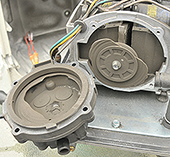
EL60 / JDK60 and above
JDK & EL Series : Power to the pump, but it appears to be dead.
Don't panic !! .. and hold off buying that new pump just for a moment .. you might not need to !
Unless your pump has experienced a catastophic failure, been flooded, or has been breathing in noxious gasses from the water treatment main tank, it's likely the pump is repairable.
Inside both JDK Series (JDK60 and above) and EL Series pumps, there is a small sliding switch (autostopper) which, when a diaphragm splits, allows the magnet (to which it is bolted) to move further than normal (twin heads have two). The magnet(s) are held in a frame which has, as part of it's design, prongs or 'horns' on the top edge, which are then allowed to come into contact with this switch and in doing so, push it off-centre. This cuts the power to the pump immediately and helps to reduce further internal damage.
On some JDK-S and EL-S pumps a red SERVICE light is visible on the external casing. This illuminates when the switch is operated.
It's likely your pump has torn a diaphragm. If so, you'll simply need to replace it (best to replace both whilst you are at it - they come in pairs). For a pump that is 4 years old or more, a service kit is a good idea.
Don't panic !! .. and hold off buying that new pump just for a moment .. you might not need to !
Unless your pump has experienced a catastophic failure, been flooded, or has been breathing in noxious gasses from the water treatment main tank, it's likely the pump is repairable.
Inside both JDK Series (JDK60 and above) and EL Series pumps, there is a small sliding switch (autostopper) which, when a diaphragm splits, allows the magnet (to which it is bolted) to move further than normal (twin heads have two). The magnet(s) are held in a frame which has, as part of it's design, prongs or 'horns' on the top edge, which are then allowed to come into contact with this switch and in doing so, push it off-centre. This cuts the power to the pump immediately and helps to reduce further internal damage.
On some JDK-S and EL-S pumps a red SERVICE light is visible on the external casing. This illuminates when the switch is operated.
It's likely your pump has torn a diaphragm. If so, you'll simply need to replace it (best to replace both whilst you are at it - they come in pairs). For a pump that is 4 years old or more, a service kit is a good idea.
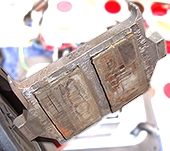
Damaged Magnet
The most important part of any Secoh pump installation is the installation itself.
So, if a pump is trying to pump with a blocked filter, or is in a container with insufficient ventilation, or (most likely) is trying to pump high volumes of low pressure air into a system which is partially (or entirely) blocked, the pump tries it very hardest (bless it) but it's going to have some problems.
It's not too common, but not entirely unknown in this scenario that the pump ends up working too hard and, by heating up, we've seen the resin holding the magnets in their carrier start to melt. The magnet can then start to become loosened in the carrier (see photo) and (as the magnets are REALLY strong) they gradually pull themselves out of the carrier and they're (usually, but not always ) toast.
We've also occasionally seen installations where the pipework the pump is blowing into has been accidentally bent or kinked, this (in a similar way to a blocked pipe) ends up with significant back pressure to the pump, the pump heats up, the diaphragms - now running at an elevated temperature - can distort and allow the magnet to move sideways. This then rubs on the sides, friction heats the whole thing up even more .. and that's that.
Solutions? .. well .. if the magnet isn't too badly damaged, you have nothing to lose by cleaning it and trying to glue it back together with an epoxy resin (araldite?)
If that doesn't work, go for a replacement magnet. .. but track back the REASON for the failure .. so blow a compressor down the pipes to clear out that blockage, check for kinked pipework, check the filter is clean and that the pump container has sufficient ventilation - let's be honest, if the pump is (for example) blowing out 200 litres of air a minute, it needs at least that amount of clean, fresh air available per minute too.
If you wish, pull the pump out of it's container and sit it nearby with a upturned wheelbarrow over it for a while before making a long term decision .. but whatever you do clear those pipes before re-installing the pump !!
So, if a pump is trying to pump with a blocked filter, or is in a container with insufficient ventilation, or (most likely) is trying to pump high volumes of low pressure air into a system which is partially (or entirely) blocked, the pump tries it very hardest (bless it) but it's going to have some problems.
It's not too common, but not entirely unknown in this scenario that the pump ends up working too hard and, by heating up, we've seen the resin holding the magnets in their carrier start to melt. The magnet can then start to become loosened in the carrier (see photo) and (as the magnets are REALLY strong) they gradually pull themselves out of the carrier and they're (usually, but not always ) toast.
We've also occasionally seen installations where the pipework the pump is blowing into has been accidentally bent or kinked, this (in a similar way to a blocked pipe) ends up with significant back pressure to the pump, the pump heats up, the diaphragms - now running at an elevated temperature - can distort and allow the magnet to move sideways. This then rubs on the sides, friction heats the whole thing up even more .. and that's that.
Solutions? .. well .. if the magnet isn't too badly damaged, you have nothing to lose by cleaning it and trying to glue it back together with an epoxy resin (araldite?)
If that doesn't work, go for a replacement magnet. .. but track back the REASON for the failure .. so blow a compressor down the pipes to clear out that blockage, check for kinked pipework, check the filter is clean and that the pump container has sufficient ventilation - let's be honest, if the pump is (for example) blowing out 200 litres of air a minute, it needs at least that amount of clean, fresh air available per minute too.
If you wish, pull the pump out of it's container and sit it nearby with a upturned wheelbarrow over it for a while before making a long term decision .. but whatever you do clear those pipes before re-installing the pump !!
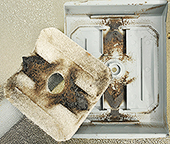
Pump runs really hot and cuts out / restarts
See above too .. same thing applies really ..
Couple of reasons this might happen. Firstly, a blocked air filter is not allowing enough air into the pump, or the chamber the pump is in hasn't got enough ventilation to allow sufficient air into where the pump is - (bear in mind if a pump is trying to deliver 200 litres of air a minute, it needs to be able to draw 200 litres of air a minute IN ! .. and that's quite a lot) or the pipework down into which the pump is blowing air might be partially or completely blocked.
Solutions? : Well, clean or replace the filter and ensure there is enough air getting to the pump. uncouple the pump from the pipework and blow high pressure air down the pipe to clear any blockages. Let the pump run for a while on a bench, uncoupled to anything and see if the pump then runs less hot.
If a pump runs hot, it can cause the diaphragms to start to distort which in turn can result in the magnet moving laterally and then rubbing on the internal casing. This can exacerbate the problem and you might well end up having to replace magnets and diaphragms or even the entire pump so it's well worth spending a few minutes investigating !
Couple of reasons this might happen. Firstly, a blocked air filter is not allowing enough air into the pump, or the chamber the pump is in hasn't got enough ventilation to allow sufficient air into where the pump is - (bear in mind if a pump is trying to deliver 200 litres of air a minute, it needs to be able to draw 200 litres of air a minute IN ! .. and that's quite a lot) or the pipework down into which the pump is blowing air might be partially or completely blocked.
Solutions? : Well, clean or replace the filter and ensure there is enough air getting to the pump. uncouple the pump from the pipework and blow high pressure air down the pipe to clear any blockages. Let the pump run for a while on a bench, uncoupled to anything and see if the pump then runs less hot.
If a pump runs hot, it can cause the diaphragms to start to distort which in turn can result in the magnet moving laterally and then rubbing on the internal casing. This can exacerbate the problem and you might well end up having to replace magnets and diaphragms or even the entire pump so it's well worth spending a few minutes investigating !
Pumps tripping the RCD, can't get it to keep running
Could be that your pump has been running hot and damaged one or more coils. If you see the plastic wrap is discoloured and the wrap seems more brittle it could well be the pump has had it's chips. Cheapest solution in this situation is to replace the drive unit. (a little cheaper than an entire new pump anyway).
You need to investigate why the pump was running so hot though (blocked pipework?)
You need to investigate why the pump was running so hot though (blocked pipework?)
Diaphragms simply don't last as long as they used to.
Once more, potentially compromised outlet pipework .. (is this starting to sound familiar yet?)
If your diaphragms last less than (say) 18 months or so, your system is telling you something.
It's probably telling you that deep down in your pipework you have some blockages starting to build up. These blockages are causing back pressure to the pump and the reduced lifespan of the rubber disks are the sign. If a pump has been off for a while the matter down inside the tank and inside the pipework is likely to be hardening up .. Secoh pumps are amazing, but they don't have the 'umph' to clear blocked pipes and the subsequent back pressure is detrimental to the pumps.
Unattach your pump from the system, blow some high pressure air down into the system to loosen and dislodge any blockages, ensure the filter is clean (or drop a new one in) and make sure the pump isn't running too hot before reattaching it to your system (see above) as this can reduce the lifespan of the diaphragms too.
If your diaphragms last less than (say) 18 months or so, your system is telling you something.
It's probably telling you that deep down in your pipework you have some blockages starting to build up. These blockages are causing back pressure to the pump and the reduced lifespan of the rubber disks are the sign. If a pump has been off for a while the matter down inside the tank and inside the pipework is likely to be hardening up .. Secoh pumps are amazing, but they don't have the 'umph' to clear blocked pipes and the subsequent back pressure is detrimental to the pumps.
Unattach your pump from the system, blow some high pressure air down into the system to loosen and dislodge any blockages, ensure the filter is clean (or drop a new one in) and make sure the pump isn't running too hot before reattaching it to your system (see above) as this can reduce the lifespan of the diaphragms too.
When to replace diaphragms and when to fit a full service kit?
With the smaller SLL and JDK pumps especially, the general recommendation is to replace annually. The SLL 40 / 50 and JDK 40 / 50 range don't have the internal autostopper switch which is in the JDK or EL (60 and above) Series, so there is the possibility of damage to the magnet when a diaphragm splits (as there's nothing in there to tell the pump it needs to stop!) We reckon the best thing to do is to have a pack of diaphragms in stock, so you have them to hand when the first set go.
After four years, fit a full service kit (this then replaces the valve boxes too). Next time just diaphragms, then a service kit, then diaphragms .. and so on. Clean the filter regularly (perhaps every three or four months) and replacing it every 12 - 18 months is a good idea.
Buy the filters at the same time as a diaphragm pack to save paying twice for shipping.
oh .. and no, the service kits don't include the magnets (there's usually no need to replace these unless they get damaged really).
After four years, fit a full service kit (this then replaces the valve boxes too). Next time just diaphragms, then a service kit, then diaphragms .. and so on. Clean the filter regularly (perhaps every three or four months) and replacing it every 12 - 18 months is a good idea.
Buy the filters at the same time as a diaphragm pack to save paying twice for shipping.
oh .. and no, the service kits don't include the magnets (there's usually no need to replace these unless they get damaged really).
How long should my pump last?
Secoh pumps are excellent quality, and there's precious little inside them to go wrong. Having said that, nothing lasts forever; Diaphragms are actuated 1.5 billion times a year or so, as are the valves in the valve boxes. Rubber elements (pipes and the like) are subjected to varying heat and humidity and sometimes are exposed in part to the corrosive elements in the smelly air within a water treatment plant (which, along with flooding, will invalidate the warranty incidentally).
Try to imagine running your car, 24 hours a day, 365 days a year .. with hardly a thought to even changing the filters or the oil. Even the most expensive vehicles would struggle to manage that; day in day out, year after year. Try opening the driver's door of your Bentley a billion times and see how nicely it still opens and closes in a few years time !
It's not unknown for Secoh pumps to last well in excess of 10, maybe even 15 years .. but the lifespan is often shortened by failings in the installation. So with a good installation and a regular maintainance schedule there's no reason why your Secoh pump can't last a considerable time.
Try to imagine running your car, 24 hours a day, 365 days a year .. with hardly a thought to even changing the filters or the oil. Even the most expensive vehicles would struggle to manage that; day in day out, year after year. Try opening the driver's door of your Bentley a billion times and see how nicely it still opens and closes in a few years time !
It's not unknown for Secoh pumps to last well in excess of 10, maybe even 15 years .. but the lifespan is often shortened by failings in the installation. So with a good installation and a regular maintainance schedule there's no reason why your Secoh pump can't last a considerable time.
What is a kPa ?
Over the years, air pressure has been measured by various names, however the latest favourite is kPa.
A kilopascal (kPa) of 1,000 newtons per square metre is commonly used. For example, standard atmospheric pressure (or 1 atm) is defined as 101.325 kPa. The millibar, a unit of air pressure often used in meteorology, is equal to 0.1 kPa. (For comparison, one pound per square inch equals 6.895 kPa.)
Various references are made for this unit within the website .. so we thought you might like to know (if you didn't already) what it was !
A kilopascal (kPa) of 1,000 newtons per square metre is commonly used. For example, standard atmospheric pressure (or 1 atm) is defined as 101.325 kPa. The millibar, a unit of air pressure often used in meteorology, is equal to 0.1 kPa. (For comparison, one pound per square inch equals 6.895 kPa.)
Various references are made for this unit within the website .. so we thought you might like to know (if you didn't already) what it was !
Things to avoid
If you've read through all the above you will probably realise there are a handful of situations which, to ensure smooth and long term running of your pump, you need to be aware of. Most of which is pretty obvious and common sense stuff.
Foul air - avoid this at all costs (pumps are not covered by any warranty if exposed to this).
Water ingress - they are rainproof, but not waterproof. Warranty is voided by any sign of water inside the pump.
Physical damage - naturally, if you've accidentall dropped it and it's been damaged, the warranty won't cover that - though your household insurance might.
Overheating - bit of a grey area, but if your pipework is in some way blocked and causes the pump to overheat and fail, or the pump is housed in a way that will not allow sufficient air to be drawn in, or if the location the pump is in is so dirty or dusty the pump is choked of air .. the warranty is void (external factors basically).
Foul air - avoid this at all costs (pumps are not covered by any warranty if exposed to this).
Water ingress - they are rainproof, but not waterproof. Warranty is voided by any sign of water inside the pump.
Physical damage - naturally, if you've accidentall dropped it and it's been damaged, the warranty won't cover that - though your household insurance might.
Overheating - bit of a grey area, but if your pipework is in some way blocked and causes the pump to overheat and fail, or the pump is housed in a way that will not allow sufficient air to be drawn in, or if the location the pump is in is so dirty or dusty the pump is choked of air .. the warranty is void (external factors basically).


